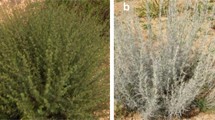Abstract
This work is concerned with the development of a simple and accurate procedure for trace elements determination in infusion of medicinal plants using neutron activation analysis. The developed scheme involves irradiation of herb (tea in the present work) before immersion into boiled water and then analyzing the induced radioactivity in the infusion using HPGe detector to determine the concentration levels of the extracted elements. Results were corrected for geometry and γ-ray attenuation effects using Monte Carlo simulation. The effects of irradiation dose and infusion period on the extraction process were also evaluated. The developed method proved its efficiency and capability for evaluation of the daily intake of elements reach our body through consumption of medicinal plants.




Similar content being viewed by others
References
O’Dell BL, Sunde RA (1997) Handbook of nutritionally essential mineral elements. Marcel Dekker Inc., New York
Seenivasan S, Manikandan N, Muraleedharan NN, Selvasundaram R (2008) Heavy metal content of black teas from south India. Food Control 19:746–749
WHO—World Health Organization (2003) Traditional Medicine, Fact sheet No. 134, May 2003. www.who.int/mediacentre/factsheets/2003/fs134/en4. Accessed 2 Aug 2019
Barua DN (2008) Science and practice in tea culture. Tea Research Association, Calcutta-Jorhat
Karak T, Bhagat RM (2010) Trace elements in tea leaves, made tea and tea infusion: a review. Food Res Int 43:2234–2252
Chung FL, Schwartz J, Herzog CR, Yang YM (3274S) Tea and cancer prevention: studies in animals and humans. J Nutr 133:3268S–3274S
Yao LH, Jiang YM, Shi J, Tomás-Barberán FA, Datta N, Singanusong R et al (2004) Flavonoids in food and their health benefits. Plant Foods Hum Nutr 59:113–122
Serfor-Armah Y, Nyarko BJB, Akaho EHK, Kyere AWK, Osae S, Oppong-Boachie K, Osae EKJ (2001) Activation analysis of some essential elements in five medicinal plants used in Ghana. J Radioanal Nucl Chem 250:173–176
Kumar A, Nair AGC, Reddy AVR, Garg AN (2005) Availability of essential elements in Indian and US tea brands. Food Chem 89:441–448
Han W, Zhao F, Shi Y, Ma L, Ruan J (2006) Scale and causes of lead contamination in Chinese tea. Environ Pollut 139:125–132
Attallah MF, Metwally SS, Moussa SI, Soliman MA (2019) Environmental impact assessment of phosphate fertilizers and phosphogypsum waste: elemental and radiological effects. Microchem J 146:789–797
Koch KR, Pougnet MA, De Villiers S, Monteagudo F (1988) Increased urinary excretion of Al after drinking tea. Nature 333:122
Yamashita CI, Saiki M, Vasconcellos MBA, Sertie JAA (2005) Characterization of trace elements in Casearia medicinal plant by neutron activation analysis. Appl Radiat Isot 63:841–846
Benson RA, Mohamed NMA, Soliman M, Hassan M, Abou Mandour MA (2017) Application of k0-INAA for evaluating the essential and toxic elements of some medicinal plants in west Pokot County, Kenya. J Radioanal Nucl Chem 314:23–29
Chizzola R, Michitsch H, Franz C (2003) Monitoring of metallic micronutrients and heavy metals in herbs, spices and medicinal plants from Australia. Eur Food Res Technol 216:407–411
Herber RFM, Stoeppler M (1994) Trace element analysis in biological specimens. Elsevier, Amsterdam, p 87
Zhang GW, Zhang H, Zhou CF, Wang Z (1997) ICP-AES determination of trace elements in tea. Lihua Jianyan Huax Fence 33:63–65
Falco G, Gomez-Catalan J, Llobet JM, Domingo JL (2003) Contribution of medicinal plants to the daily intake of various toxic elements in Catalonia, Spain. Trace Elem Electrolyte 20:120–124
Cao X, Zhao G, Yin M, Li J (1998) Determination of ultratrace rare earth elements by inductively coupled plasma mass spectrometry with microwave digestion and AG50W-x8 cation exchange chromatography. Analyst 123:1115–1119
Lu HT, Mou SF (2000) Simultaneous determination of copper, nickel, zinc, cadmium, cobalt, manganese and lead in tea by ion chromatography. Lihua Jianyan, Huaxue Fence 36:51–54
Salvador MJ, Lopes GN, Nascimento FVF, Zucchi OLAD (2002) Quality control of commercial tea by X-ray fluorescence. X-Ray Spectrom 31:141–144
Soliman M, Mohamed NMA, Gahen M, Saad EA, Yousef SK, Sohsah MA (2011) Implementation of k0-standardization method of the INAA at ETRR-2 research reactor. J Radioanal Nucl Chem 287:629–634
Mohamed NMA, Mandour MA, Shaat MK, Badawi AA (2006) Evaluation of the efficiency of gamma spectrometers for analyzing environmental samples with unknown elemental composition. Nuclear Technol 153:360–364
Abdo FS, Soliman M, Ahmed M, Rizk R, Megahid R (2016) Calibration of HPGe detector for flowing sample neutron activation analysis. J Radioanal Nucl Chem 307:1413–1418
Stamatelatos IE, Tzika F, Vasilopoulou T, Koster-Ammerlaan MJJ (2010) Large sample neutron activation analysis of a ceramic vase. J Radioanal Nucl Chem 283:735–740
Haddad Kh, Boush M (2011) Validation of MCNP volume efficiency calculation for gamma spectrometric assay of large NORM samples. J Radioanal Nucl Chem 289:97–101
Lagad RA, Dasari KB, Alamelu D, Acharya R, Aggarwal SK (2014) Evaluation of soil to tea plant elemental correlation using instrumental neutron activation analysis. J Radioanal Nucl Chem 302:1507–1512
Zhang HQ, Ni BF, Tian WZ, Zhang GY, Huang DH, Liu CX, Xiao CJ, Sun HC, Zhao CJ (2011) Study on essential and toxic elements intake from drinking of Chinese tea. J Radioanal Nucl Chem 287:887–892
Alrehaily LM, Joseph JM, Wren JC (2015) Radiation-induced formation of chromium oxide nanoparticles: role of radical scavengers on the redox kinetics and particle size. J Phys Chem C 119:16321–16330
Zhernosekov K, Filosofov D, Rösch F (2014) The Szilard-Chalmers effect in macrocyclic ligands to increase the specific activity of reactor-produced radiolanthanides: experiments and explanations. Radiochim Acta 100:669–674
National Institute for Health, USA, Dietary Reference Intakes (DRIs). https://www.ncbi.nlm.nih.gov/books/NBK56068/table/summarytables.t3/?report=objectonly. Accessed 15 Jan 2020
Author information
Authors and Affiliations
Corresponding author
Additional information
Publisher's Note
Springer Nature remains neutral with regard to jurisdictional claims in published maps and institutional affiliations.
Rights and permissions
About this article
Cite this article
Soliman, M.A., Abdou, F.S. & Mohamed, N.M. Novel neutron activation analysis scheme for determination of trace elements in medicinal plants infusion. J Radioanal Nucl Chem 325, 841–846 (2020). https://doi.org/10.1007/s10967-020-07194-6
Received:
Published:
Issue Date:
DOI: https://doi.org/10.1007/s10967-020-07194-6




